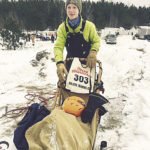As most outdoor-loving Minnesotans know, there is cold and then there is cold. The first kind of cold you can tolerate and enjoy your outdoor activities. The second kind of cold is bitter, makes you miserable and is best avoided. We had one morning during the recent deer season that was the second kind of cold.
At daybreak the temperature hovered near zero, which is warm enough for hunting if you are sufficiently bundled up or spending your morning in a heated blind. I prefer to stay on my feet, moving quietly and slowly, focused on my predatory game. When it is that cold, I get chilled and lose my focus, which defeats the purpose of being out there. My hunting partner and I decided to wait until the day began warming up before heading into the woods.
It was mid-morning when I chambered a round and set out to find a buck. Most deer hunters sit and wait for a deer to come to them. I prefer to go where the deer are now. It’s the old way of hunting Northwoods whitetails. It may not work for everyone, but it works for me.
The cold snow was crunchy underfoot, so the standard still-hunting technique—taking a couple of silent steps, then pausing—was out of the question. I decided to try an alternative strategy—walking quietly to a likely spot and then standing still until becoming impatient or cold. At that point, I could quietly walk to another spot.
I walked to a place on the edge of a balsam stand where bucks often hang out, taking care to not step on sticks or make other, oh-so-human sounds. Then I stopped beside a couple of big balsams that provided some natural cover. Almost immediately, I heard the crunchy footsteps of an approaching deer. Squatting to peer beneath the evergreen boughs, I moved the Model 70’s three-position safety to the half-safe position. Soon a forkhorn stepped into view, perhaps 50 feet from me. He looked curiously at me, knowing my unfamiliar shape wasn’t there the last time he passed by, but unable to catch a whiff of my scent. I decided against shooting him, preferring to wait for a buck with more meat on his bones. As he walked away, on a whim I gave a bleat on a call. Bad move. The forker paused, still in sight. Why did I do that?
My squatting position was becoming unbearable, but I didn’t dare move. Then I heard a second deer approaching from behind me. After a few uncomfortable minutes, the forkhorn walked away. Unable to turn to see if the second deer was in sight, I rose slowly. Straightening up, I turn to catch a flash of the deer bounding away.
I’ve had deer respond to rattles, grunts or bleats, but I’ve mostly given up using calls. Too often the call allows an unseen deer to pinpoint your location, approach and then stop just out of your sight, where it will patiently wait until it can verify the sound it heard was indeed made by a whitetail. That’s exactly what the second deer did when I bleated at the forkhorn.
It was time to walk again. As I did, it struck me that the two deer had heard my walking footsteps and were attracted to the sound. I’ve noticed in the past that an approaching wolf always comes right at you, almost certainly attracted by the noise you’ve made. There is no reason a deer won’t do the same thing, especially during the rut. This may seem to contradict my rationale for not using calls, but it has happened to me often enough to rule out coincidence.
After going perhaps 150 yards, I stopped a second time. Once again, a deer immediately approached; a spike buck. He began slowly circling around me. When he reached a place where he had a clear view of me, he paused, faced me and stamped his right front foot. Deer often stamp their feet when they perceive danger. This was different. The little buck was challenging me. I stayed motionless as we faced off, perhaps 40 feet apart. The challenge stamps continued for five or 10 minutes. Then, with prancing steps, the spiker walked completely around me, making it clear that he was the boss of this half-acre patch of hazel brush. Then he pranced out of sight, although I could still hear him for another 10 minutes.
When sounds of the spiker faded, I walked another 150 yards and stopped beside the camouflaging cover of a big balsam. I sat on a log for a couple of minutes, but decided it was a confining position if a deer approached. As I stood up, I heard the crashing sound of a running deer. Had I spooked it? No. It was coming my way.
The buck came in fast, right at me, screened by brush and balsam boughs. He carried a small eight-point rack. I moved to a ready position and pushed the safety to the half-safe position, which made a barely audible click. The buck heard it and stopped. He was on full alert, certain to bolt at any moment, and less than 30 feet away from me. Through the brush, I had a clear view of a plate-sized piece of his neck and chest. I centered the crosshairs on that spot.
I had a split-second to decide whether to shoot. If I let him walk, next year his antlers might be bigger. I’ve yet to find a good recipe for antler soup. Silently slipping the safety off, I squeezed the trigger.



